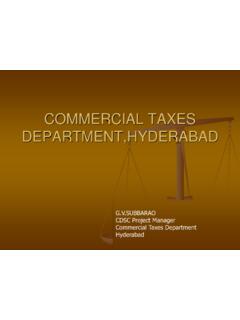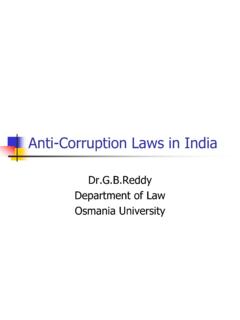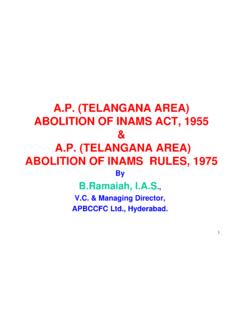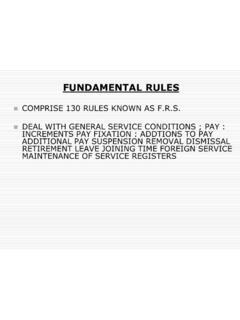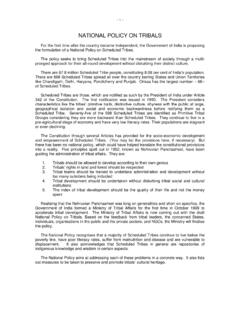Transcription of Infrastructure Development in India
1 Infrastructure Development in India 1 By Nair Deputy Director & Associate Professor, CUDS, DR MCRHRD IAP Roads India has one of the largest road networks in the world, aggregating to million km. The country s road network consists of Expressways, National Highways, State Highways, Major District Roads, Other District Roads and Village Roads. The road network, as on December 2007, comprises 66,590 km of National Highways, 128,000 km of State Highways, 470,000 km of Major District Roads and about million km of other District and Rural Roads. National Highways comprise only about 2 percent of the total length of roads and carry about 40 percent of the total traffic across the length and breadth of the country. 2 The National Highways Development Project (NHDP), the largest highway project ever undertaken by the country, is being implemented by the National Highway Authority of India (NHAI). NHDP Phase I & II envisage 4/6 laning of about 14,279 km of National Highways, at a total estimated cost of million (at 2004 prices).
2 These two phases comprise of Golden Quadrilateral (GQ), North-South and East-West Corridors, Port Connectivity and other projects. 3 Ports India s coastline of 7,517 km. is added with 13 major ports and 187 non-major ports. Of the non-major ports, around 60 are handling traffic. The total traffic carried by both the major and minor ports during 2005-06 was estimated at around 570 million tonnes. The 12 major ports carry about 3/4th of the total traffic, The annual aggregate cargo handling capacity of major ports increased from million tonnes per annum (MTPA) in 2004-05 to MTPA in 2005-06, with the average turnaround time increasing marginally from days to days in 2005-06. 4 Airports 5 11 international airports 114 domestic airports 20%annual growth Passenger traffic crossed 100 million passengers Cargo traffic to grow at over 20% over the next five years - Inbound traffic also on rise due to trade and investment Maintenance, Repair and Overhaul (MRO) growing in a big way India has one of the largest railway networks in the world (63,000 route KMs network) Accounts for 30% of total freight traffic Traffic volumes set to double by 2012 The high-density network connecting the four metropolitan cities of Chennai, Delhi, Kolkata and Mumbai, including its diagonals, popularly called the Golden Quadrilateral has got saturated at most of the locations.
3 Potential for rolling stock, locomotives, passenger coaches, track equipment, signaling equipment Railways Power Since independence, generating capacity has increased from 1362 to over 100,000 MW However there are widespread shortages of power in almost all parts of the country. Inadequate inter-regional transmission links; Inadequate and ageing sub-transmission & distribution network leading to power cuts and local failures/faults; Large scale theft and skewed tariff structure; Slow pace of rural electrification; Inefficient use of electricity by the end consumer. 7 Status of Urban Infrastructure The growth of population has put urban Infrastructure and services under severe strain. Smaller cities have found it particularly difficult to cope with the increasing demands on services because of inadequate financial resources. Urban areas in India , present a grim picture with regard to availability of basic Infrastructure .
4 India : Projected Urban Population (Millions) Urban Infrastructure - Statistics About 21 per cent of the urban population is living in squatter settlements, where access to basic services is extremely poor. Although 89 per cent of the urban population is reported to have access to safe drinking water but there are severe deficiencies with regard to equitable distribution of water. Recent data suggest that water supply is available for hours per day across cities and towns. The non-revenue water that includes physical and revenue losses account for 40-60 percent of total water supply. About 30 to 50 percent households do not have sewerage connections and Less than 30 percent of total waste water is treated. Solid waste systems are severally stressed. Average per capita generation of waste is estimated at kg per capita per day in cities ranging from 1 lakh to 50 lakh population and the garbage collection efficiency ranges between 50 to 90 per cent of the solid waste generated.
5 City roads are inadequate for traffic requirements, leading to congestion and fast deterioration in quality of roads due to excess loads. The state of services reflects the deterioration in the quality of city environments. 12 Infrastructure scenario: India snapshot existing Infrastructure under tremendous pressure Sector Infrastructure deficit at the beginning of 11th FYP Roads/Highways 65,590 km of NH comprise only 2% of network and carry 40% of traffic Single-laned: 38% 2-laned: 50% 4-laned: only 12% Power peaking deficit; energy shortage; 40% transmission and distribution losses Railways Old technology Saturated routes Slow speeds (freight: 22kmph; passengers: 50kmph) Low payload to tare ratio ( ) Airports Inadequate runways, aircraft handling capacity, parking space and terminal buildings Ports Inadequate berths and rail/road connectivity Source: Eleventh Five Year Plan, Planning Commission, Government of India 13 Infrastructure scenario: India snapshot existing Infrastructure under tremendous pressure Water supply quantity (Litres per capita per day) Sewage treated (%age of sewage generated) Solid waste collected (%age of total waste generated) Health care (Hospital beds per 1,000) Education (Student-to-teacher ratio in primary schools) Parks and open space (square meters per capita) Source: India s urban awakening, April 2010, McKinsey Global Institute Inadequate Infrastructure affecting Indian cities India is the second fastest growing economy.
6 Inadequate Infrastructure : significant constraint on India 's growth potential retards GDP growth rate by 1-2 % (estimates) acts as a major barrier to Foreign Direct Investment hinders the objective of Inclusive Development Eleventh Five Year Plan recognizes that adequate, cost-effective and quality Infrastructure is a pre-requisite for sustaining the growth momentum. This is reaffirmed in the approach documents to the 12 FYP 14 The expert group on commercialization of Infrastructure estimated the loss due to poor roads and congestion at around Rs 200 billion per annum. This is just one Infrastructure scenario: India snapshot Infrastructure needs 10th Five Year Plan2002-200711th Five Year Plan2007-201012th Five Year 07 - 08 08 - 09 09 - 10 10 - 11 11 - 12 12 - 17218 514 1025 10th Five Year Plan2002-200711th Five Year Plan2007-201012th Five Year Plan2012-201715 Accelerating economic growth GDP growth rate targets Requires increasing Infrastructure investments Required Infrastructure investment in % of GDP.
7 And increasing Infrastructure finance needs Amount of Infrastructure investments in USD billion ..and increasing need for private finance Private finance as % of total finance need 5% 10th Five Year Plan2002-200711th Five Year Plan2007-201012th Five Year Plan2012-2017 Sources: Investment in Infrastructure March 2010 the Infrastructure gap in the country was holding back economic growth by per cent every year Mr P. Chidambaram, Former Minister of Finance Infrastructure scenario: India snapshot Infrastructure needs 50% in the 12th Five year plan under finalization 16 Projected Investment in Infrastructure X Plan XI Plan Sectors US $ billion Share (%) US $ billion Share (%) Electricity (incl. NCE) Roads and Bridges Telecommunication Railways (incl. MRTS) Irrigation (incl. Watershed) Water Supply and Sanitation Ports Airports Storage Gas Total US $ billion 100 100 Rs.
8 Crore 871,445 2,060,193 17 Projected Eleventh Plan Sector Share (%) Electricity32%Roads 15%Telecom13%Railway s13%Irrigation12%Water Sup p ly and Sanitation7%Ports4%Airp orts2%Gas1%Storage1%18 Infrastructure scenario: India snapshot Infrastructure needs: bridging the gap Investment gap Gap between existing and required Infrastructure Improving the availability of Infrastructure by increased investment in the Infrastructure assets As per the 11th Five year plan, the gross capital formation (GCF) in Infrastructure should rise as a share of GDP from 5% in 2006-07 to 9% by the end of the plan period (2011-12) Efficiency gap Need to enhance quality of service, minimum acceptable standards of service Options to bridge the gap Traditional public procurement Public Private Partnerships (PPPs) Privatisation PPPs are an option to supplement scarce public resources and improving efficiencies without necessarily transferring ownership to the private sector Bharat Nirman Programme to develop rural Infrastructure at an estimated cost of Rs.
9 1,74,000 crore (~US$40 billion) Jawhar Lal Nehru Urban Renewal Mission Rs. 100,000 crore (US$22 billion) Country wide rural connectivity programme to link all unconnected village having population of 500 with fair weather road undertaken Recent Infrastructure Initiatives Introduction to PPP Understanding PPP Concepts and Principles Objectives of the Training Module To introduce the basic concepts and rationale for PPPs 21 Basic concepts of PPPs (What is PPP?) Key Concepts Definition of PPPs Common characteristics PPPs in comparison with traditional public procurement Common myths and concerns related to PPPs Rationale for PPPs (Why PPP?) Key Concepts Potential advantages of PPPs Possible concerns of PPPs How to do PPP? Key Concepts Common PPP models Critical success factors across PPP Life cycle Common pitfalls to avoid Pedagogical Tools Case examples explaining different PPP modal variants Introducing PPP Structure of the Training 22 Effective and Efficient Delivery of Public Services How to do PPP?
10 Understanding the Common PPP models and Critical Success Factors What is PPP? Understanding the Characteristics of PPPs, common myths & concerns Why PPP? Understanding the Rationale for PPPs Introducing PPP What is PPP? Basic concepts of PPPs (What is PPP?) Key Concepts Definition of PPPs Common characteristics PPPs in comparison with traditional public procurement Common myths and concerns related to PPPs What is PPP? Defining PPPs 25 department of Economic affairs , Govt. of India defines Public Private Partnerships (PPPs) as : An arrangement between government or statutory entity or government owned entity on one side and a private sector entity on the other, for the provision of public assets and/or related services for public benefit, through investments being made by and/or management undertaken by the private sector entity for a specified period of time, where there is a substantial risk sharing with the private sector and the private sector receives performance linked payments that conform (or are benchmarked) to specified, pre-determined and measurable performance standards.
